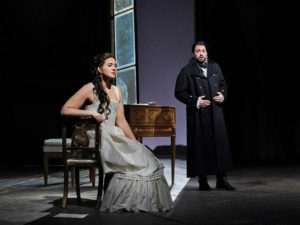
Metropolitan Opera 2019-20 Review: The Queen of Spades
Yusif Eyvazov, Lise Davidsen, Vasily Petrenko Shine In Fantastic Elijah Moshinsky Production
By David Salazar“The Queen of Spades” is a truly challenging opera to cast, relying on a top tenor that can navigate a complex role. Flanking him are a plethora of other signature roles for two baritones, two mezzo-sopranos, and a soprano. Finally, a good performance of “The Queen of Spades” doesn’t just feature solid singing, but an overall visual immersion that can sustain the momentum of an opera that features a plethora of short scenes cut together to create a tragic whole.
The Met Opera performance of the opera on Dec. 5, 2019 really hit the right beats and notes throughout in what is undeniably one of the strongest performances to date of the company’s still young 2019-20 season.
Chiaroschuro
What makes “The Queen of Spades” arguably Tchaikovsky’s most complete and complex opera is its tonal shifts in its thematic material and music. It opens with a choral sequence full of youthful children before moving onto the frivolity of soldiers ranting about card games. Then it shifts to the brooding of its central protagonist Hermann before moving into darker and darker terrain that includes talks of a fateful prophecy, suicide, failed love, fear, death, and even the beyond. Right in the middle of it all, the opera finds time for a seemingly frivolous pastorale accompanied by rococo music that counteracts Tchaikovsky’s increasingly dark and tormented score.
But just as the opera ends its darkest scene with Lisa’s suicide, it jumps back to the fun of a card game, replete with a drinking song followed by an anthem for gamblers. Of course, this being “The Queen of Spades,” tragedy comes back with a vengeance with Hermann committing murder. That the opera ends on a note of hope and prayer simply completes the glorious nature of this masterpiece.
At the Met, Tchaikovsky’s complex storytelling was furthered by Elijah Moshinsky decades-old production. The concept of Chiaroschuro is amply utilized in his production with the lighting design by Paul Pyant arguably the main protagonist throughout. The opening scenes feature an overall even or flat lighting aesthetic with the contrast mainly explored through the wardrobe by Mark Thompson. But as the opera develops and the story’s darkness seeps through the lighting darkens with the main portion of the stage engulfed in black during Lisa and Hermann’s final scene. Black becomes increasingly prominent in costuming as well as we build to this emotional climax with only Lisa’s white dress, a symbol of her purity and innocence, providing the lone contrast. She is thus symbolized as a beacon of hope within this increasingly violent world; of course, she winds up dead when all is said and done.
The character of Hermann appears in every single scene and gets some of Tchaikovsky’s most heroic and passionate music. Many scholars have noted that the composer himself might have seen himself reflected in the protagonist’s outsider status and in the context of the melodrama, Hermann’s desire to learn the Countess’ secret comes from his desire to rid himself of this status. But Hermann, in a more modern lens, can be viewed as the epitome of a toxic male, manipulating Lisa’s feelings with threats of his death and then tossing her aside in favor of winning some card game. He is the alienated man who sees more pleasure in gambling and fails to appreciate love once he’s obtained it. Hermann’s nihilistic monologue near the end of the opera emphasizes that life is but a game and that anyone is bound to die at any moment. Of course, death leads him to repentance, but watching his journey is undeniably a complex one for the audience, further emphasizing this light and dark motif that is so prevalent in the work. To explore this further, Thompson gives Hermann a black costume for the duration of the opera, putting him in immediate contrast with Lisa’s white as well as the grey of Tomsky, who is shown to be a murkier character from a moral standpoint.
The costuming for the Countess, an imposing black gown emphasizes her initially as Hermann’s equally dark equal, before shifting to a haunting red that dominates the opera’s final moments in blinding fashion.
The sets further enrich the shape of the story. A massive frame hangs over the proscenium, immediately trapping its characters and society within it. From there, we see a shift from an icy and metal first scene with a tiny construction of a city upstage, followed by a golden cage for Lisa’s room that eventually opens up and turns into a dark chamber when Hermann arrives. A golden salon follows for the big social gathering, suggesting the metallic set of the opening in its frivolity. This one is followed by a dark room that Hermann slowly opens up into a larger space dominated by the portrait of the Countess. Then we move to almost pure black and bare set to represent Lisa’s fall before returning to the lavish opulence for the card scene. Again, the sets, constantly shifting from lavish to bare, draw out this contrast between death and life at the core of the story. Within these frames, Hermann is often staged on the margins of the frame or even outside of it at the end of the first scene of Act two. Only when he is alone or in an intimate exchange with Lisa, and thus in control of the situation, does he get to occupy more of the center of the staging.
Every element in the visual component of the production is truly immersive and serves the story that is already so powerfully explored in this masterpiece of an opera.
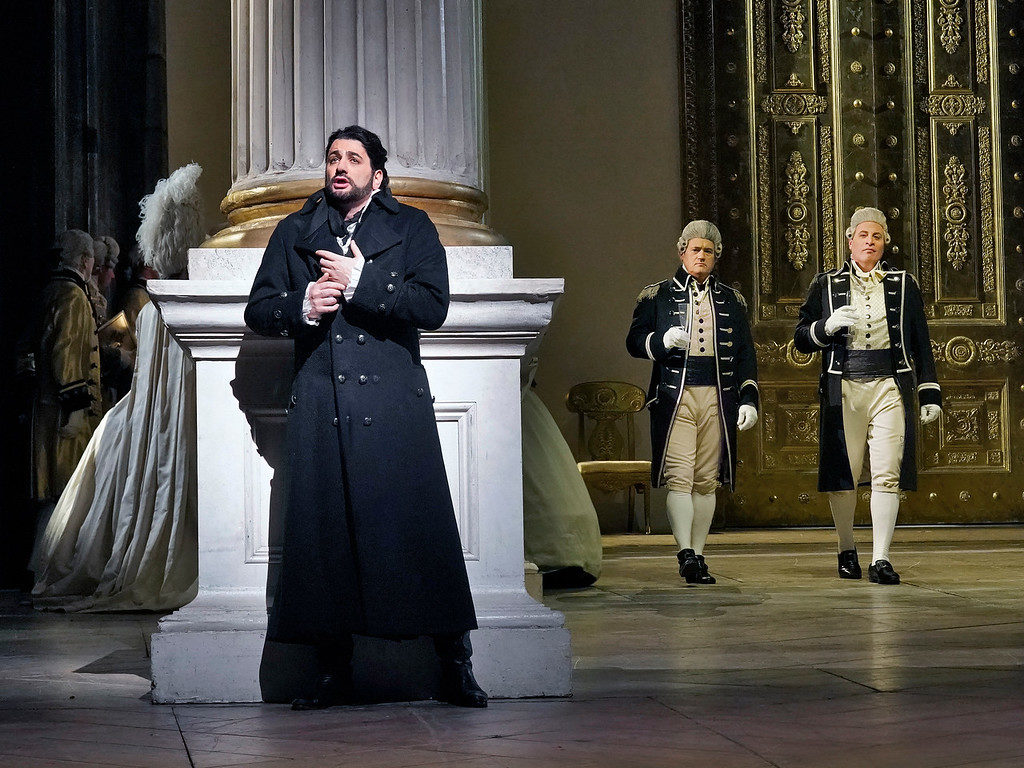
(Credit: Metropolitan Opera / Ken Howard)
Vocal Extremes & Restraint
Any good performance of this opera needs a good Hermann. Tenor Yusif Eyvazov proved more than up to the task, delivering what is likely his best interpretation to date at the Met (his “Fanciulla del West” is right there also). Through his singing, Eyvazov managed to explore Hermann’s emotional instability through vocal extremes, all well-supported technically.
But he wasn’t immediately at his best and seemed to struggle a bit in warming up to the task. While his stage presence immediately cast a shadow on the stage for its depressed and dark manner, his voice sounded a bit soft and underpowered for much of the first scene. His first arioso, “Ja imeni jejo ne znayu,” was beautifully delivered with the tenor showcasing some remarkable high notes, the three high As bright and solid in their execution. The line was connected and there was a sense of drive and intensity building throughout the aria. And yet, it was restrained and you sensed that Eyvazov was holding off to some degree.
This was furthered at the end of the scene during the final storm where the tenor simply could not compete with the orchestra, his voice sounding increasingly overwhelmed. That isn’t to say that he sounded pushed or forced in any way. Again, his sound was consistent and his singing well-supported, the upper range very solid. But all didn’t seem right.
But that changed in the ensuing scene with Lisa where he seemed to be brimming with vocal confidence from the start of that scene, his sound soft and gentle at first and then building as he tried to calm Lisa’s angst, his voice crescendoing beautifully at one point from a G natural whole note into a High A natural. But the aria that followed was the true gold, with the tenor holding nothing back. While he started off with the gentlest of sounds, early on in the aria’s second phrase, he added weight to an A natural at the apex of a sequence, hinting at the climb to the phrase’s climactic high A natural which he delivered with what felt like the sound of ferocious desperation; the following notes were similarly accented and the remainder of the aria was interpreted with similar emotional abandon. The consonants were given added emphasis, giving the overall aria a sense of heightened emotional nakedness. As noted, Hermann is a hard character to fully connect with at times, but this was the moment where you could see him as a lonely human desperate for connection.
This vulnerability was present throughout the remainder of the performance, with Eyvazov seemingly getting better and better as the night wore on at exploring Hermann’s emotional instability through vocal extremes. He started off quiet and gentle in his scene with the countess, but then shifted to singing fortissimo as the tension built, an effect that allowed you to truly empathize with the Countess in this moment. In the ensuing scene he sang with darker and more subdued tones, but his fear was potently expressed when he interpolated one of the recitative lines into a higher tessitura. He matched Davidsen note for note in their final duet in Act three; while they were united and melded well together, it also felt as if they were given liscense to simply unleash their sounds in contest with one another, suggesting the disconnect between the two.
In his final scene, there was a sense of control and measurement as he sang his final aria, his sound bright and even suggesting the first bit of sunshine in his interpretation of the misanthropic Hermann. But then Eyvazov’s ferocious vocal approach returned with a vengeance as he moved to kill himself, only to do a quick turnaround and deliver some of his finest piano singing in the death scene.
His physicality didn’t always match his vocal elegance and variety, but there is no doubt that this was a major Met moment for the tenor. Hopefully, his presence will mean that this opera won’t have to wait another decade before re-appearing on the Met stage.
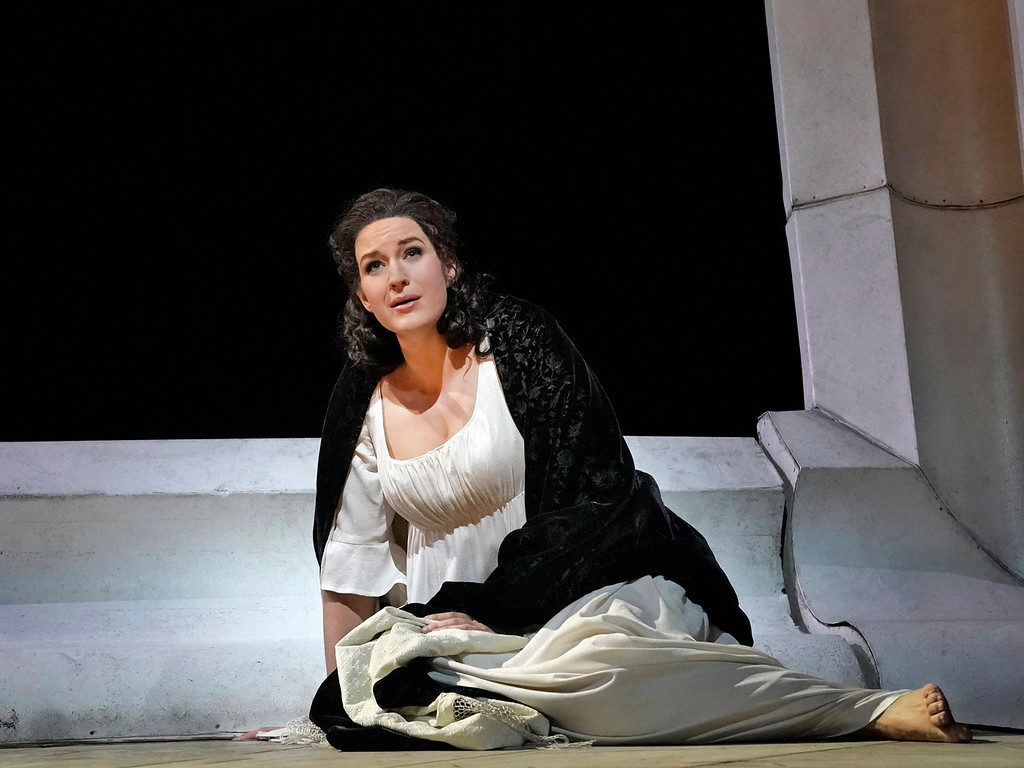
(Credit: Metropolitan Opera / Ken Howard)
Voice in a Million?
For many, this performance was not really about Eyvazov or perhaps even Tchaikovsky at all – it was about seeing soprano Lise Davidsen, who was recently signed up for six operas over the next three seasons. She has been hailed as a major dramatic soprano with Antonio Pappano heralding her as a “voice in a million.” While enthusiasm around rising stars is never a negative, it does create the problem of hype, something that a lot of singers over the past decades have never quite lived up to.
Davidsen is probably one of the few who actually does with the added caveat that at 32, her voice is not a finished product as some might suggest. There are many instances where her sound and pitch lose stability, particular between E and A flat above the stave, situations that were present throughout her two big solo moments in Act one and three; her sound tended to lose its focus and take on a pitchiness that affected the evenness of the line.
Her stage presence was also a bit uneven throughout, though perhaps some of this was more to due with the stage direction at times than her own commitment. At one point as she was threatened by Eyvazov in their first scene, she grabbed a chair and fell backward. While the intention was clear and palpable, the execution was likely a bit overwrought and drew some unnecessary laughter from the audience. At other instances in this particular scene, here running from one place to the other also seemed a bit awkward dramatically and only lessened Lisa’s sense of strength, even if she was frightened in the moment.
With her, the “less is more” concept worked best with the soprano’s more subtle gestures far better suited to her singing. This was undeniably present in the third act where you felt her move from desperation to excitement to heartbreak and then toward her decision to kill herself. She did all of this with the most subtle of physicality.
But those are the only real things that you could criticize in an otherwise superlative performance. Davidsen’s instrument is massive and even from the orchestra section, which is arguably one of the least favorable spots in the Met for a listening experience, you could hear her clearly. Her forte sound resounded the hall and her softer singing resonated just as wondrously. You really felt that she was “filling” the hall.
She proved a fantastic vocal partner in the first ensemble and then in her duet with Pauline, melding her voice beautifully in the tapestry of both passages while retaining a strong presence nonetheless.
When she was finally allowed to sing on her in Act one aria “Zashem zhe eti slyozy,” you really got a great sense of her best qualities and the challenges. Her singing captivated in its gradual bloom to a forte G flat, really giving the audience a sense of its amplitude. She retained a strong presence in the Poco più animate section that followed before hushing to the most delicate of piano sounds, which she retained throughout the ensuing repetition of the main melody. Again, she crescendoed, allowing her voice to unleash even more surprising power. This push and pull became more present as the passage developed, growing in intensity each time, the higher notes gaining greater stability, the high B flat of particular Wagnerian beauty.
But, her shining moment was undeniably the third Act solo “Utzh polnoch blizitsya,” that commences the second scene. This section is set in the lower and middle registers in the soprano voice, which proved a solid match for Davidsen. She expanded on the opening recitatives leading up to the Andante molto cantible, her sound descrescendoing delicately and thus setting up the aria proper for a truly introverted approach. The opening stanzas of the aria were sung with very restrained sound and even ascensions into the high G and subsequent turn on F-G-F retained this delicacy of sound, giving it an emotional tension that one feels from the desire to hear the voice explode with greater sound. She maintained a slow tempo throughout, creating the sense of desolation and fear Lisa feels, stretching out the final eighth notes leading up to the fermata before the fortissimo sections to create an agonizingly beautiful effect. It allowed the ensuing forte to explode with energy and Davidsen allowed her voice to blossom incredibly to the high A and high B natural at the apex of this brief phrase before winding down yet again a hallow but foreshadowing ritenuto at the lowest reaches of her range.
The ensuing section of the solo (what one might see as a “cabaletta” of sorts), was fiery and fierce, the soprano throwing caution to the winds and letting her voice explode with sound. The tessitura on this section is higher in the voice and throughout, you could sense of the aforementioned instability, but the excitement was so high that Davidsen drew you in with the intensity of her characterization, Lisa full of frenzy and desperation. She had an amazing crescendo up an F sharp-G natural-G sharp-A natural– B flat, the final note packing a wallop.
When this very melody came back a few moments later in the duet with Eyvazov, Davidsen managed to not only find another gear of intensity in her music making, but also balanced wonderfully with her stage partner.
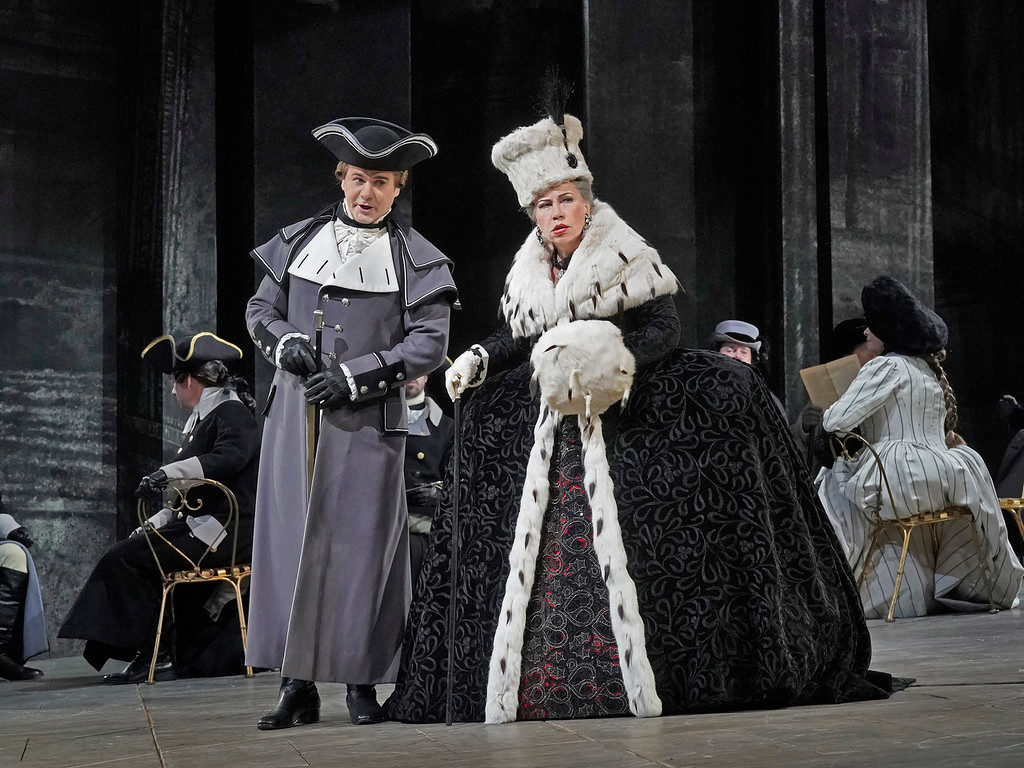
(Credit: Metropolitan Opera / Ken Howard)
Intergenerational Tension
Mezzo-soprano Elena Maximova interpreted the role of Pauline and delivered a truly wonderful performance that was most remarkable for her “triple threat” display. Not only did she provide a bubbly foil to Davidsen’s Lisa in their initial scene together, but she also blended her sound with her soprano counterpart gloriously during their initial duet. Her display during the pastorale was undeniably her most impressive of the night, the mezzo showing herself very capable of keeping up with the ballet troupe throughout.
Of course, Pauline’s big moment is her “Podrugi milyye” in scene three of Act one. Maximova’s sound, while exhibiting a nasal quality, luxuriously managed the lower and middle parts of her range between a low B flat and E flat an octave and a half above. There was a vibrant connection between the notes with the melancholic nature of the sound heightened by her more reserved approach, the voice somewhere between mezzo-piano and mezzo-forte. That said her voice did seem to lose its focus in upper ascensions to a G flat and the climactic high A flat near the close of the piece with the vibrato widening and the pitch becoming unstable. It must be noted that despite the potential shortcomings of the high A flat, the phrase-building toward that climax was powerful, the mezzo-soprano relying solely on the potency of her sound without rushing the tempo to build intensity. If not for those highs, this interpretation was vocal elegance embodied.
As the Countess, Larisa Diadkova cut an imposing presence in her early scenes, moving about with slow but calculated gestures that emphasized her sense of control. Her glare and large dresses only added to her sense of power and strength. This was furthered in her big scene at the close of Act two where she chides her handmaids for their false flattery before monologuing on the lost past, noting at one point, “I hate the world today.”
Tchaikovsky gave her “Je crains de lui parler la nuit” from Grétry’s “Richard Coeur-de-Lion” as a melancholic moment of remembrance. Diadkova’s voice is weary and dried up, the resonance minimal and the intonation, especially in the lower reaches is very unstable (this aria features a lot of singing below the stave, much of it marked ppp). But she managed to turn these perceived misgivings into qualities, allowing the audience to see the Countesses’ own sense of inner powerlessness; a truly moving contrast to the sense of fear she seeks to project into society.
As Count Tomsky, Alexey Markov made a notable impression with his thick and creamy baritone. He was visibly the most involved of characters, seemingly in control of every situation, but also very sensitive to Hermann’s troubles.
While he sings throughout, he gets two notable solo numbers in the first and final scenes of the opera. At the top of the show is “Odnazhdy v Versale,” his recount of the Countess’ past, which presents one of the opera’s major music motifs. He sang the aria with delicate and hushed sounds, imbuing it with a sense of mystery, pulling the audience in. He was even softer on the slow and prolonged repetitions of “Oh God” before building up to the more matter of fact expressions of “Three cards.” The melody’s repetition drew out a graver sound, turning the initial mystery into something darker and graver. From here he allowed his voice to build in intensity, the monologue shifting from trivial to suspenseful. In the closing pages of the aria, he shifted up and down in his vocal temperament, adding to this tension until his voice really unleashed its full potential on the climactic repetitions of “Three Cards,” the final high G blasting into the hall.
At the end of the opera, he gets a more frivolous song “Yesli b milyye devitsy.” Markov managed a playful rendition, his soft singing connected but still creating an effect of separation between notes. He capped each of the two stanzas with a solid high F natural fermata.
As Prince Yeletsky, Igor Golovatenko delivered a really strong performance. The Prince is Hermann’s foil with Lisa herself monologuing about how he is probably the perfect match for her in marriage. As such, he always looked poised and in control whenever he appeared onstage. Even in his final duel with Hermann, a scene in which he is bloodthirsty, Golovatenko retained the elegance of the nobility, providing stark contrast to Eyvazov’s more disconcerted characterization.
But of course, people’s main interest with regards to Yeletsky is his big aria, “Ya vas lyublyu,” arguably the most renowned passage from the entire opera. It’s a glorious melody and it was more beautiful than usual in Golovatenko’s rich baritone. While he did show some pitch instability in the lower sections of the aria’s first measures, namely between the B flat and E flat, his voice really blossomed on the higher E flats and F naturals where much of the aria resides; this was most evident in the first F natural preceding the Un poco più animato section, the voice opening up and crescendoing into the ensuing passage of notes before backing off.
His repetition of the main melody featured even greater emotional extremes with the baritone starting off softer and gentler before building with greater intensity. You sensed that the emotional shift in the aria from pure love to a more desperate and frustrated one, the baritone unleashing his voice amply on the high G at the climax of the aria and then slowly diminuendoing, as if Yeletsky were coming to terms with the rejection and backing off. He allowed this emotional and musical progression to unfold throughout the final phrase of the aria, each one softer and more relaxed Where most baritones might throw off the final high E flat with all they’ve got left, Golovatenko took a more measured approach and allowing the aria a more dignified conclusion of a man coming to terms with his situation and accepting it.
A spotlight must be placed on Leah Hawkins in the very brief role of Masha. Most of the time, these roles don’t really register much of an impact due to their brevity, but Hawkins’ warm and shiny timbre provided a nice complement to Davidsen’s more reserved and darkened tone in their brief exchange.
As Sourin and Tchekalinsky, Raymond Aceto and Paul Groves managed to provide the opera with a sardonic edge. They grated against you for their pointed but cheery bullying of Hermann. They were at the core of the famed gambling song near the end of the opera.
Jill Grove also made the most of her single appearance, her rustic sound providing a perfect counterpoint to Maximova’s preceding aria; there was a sense of a generational shift between the two characters and their differences, adding yet another layer to this opera full of foils.
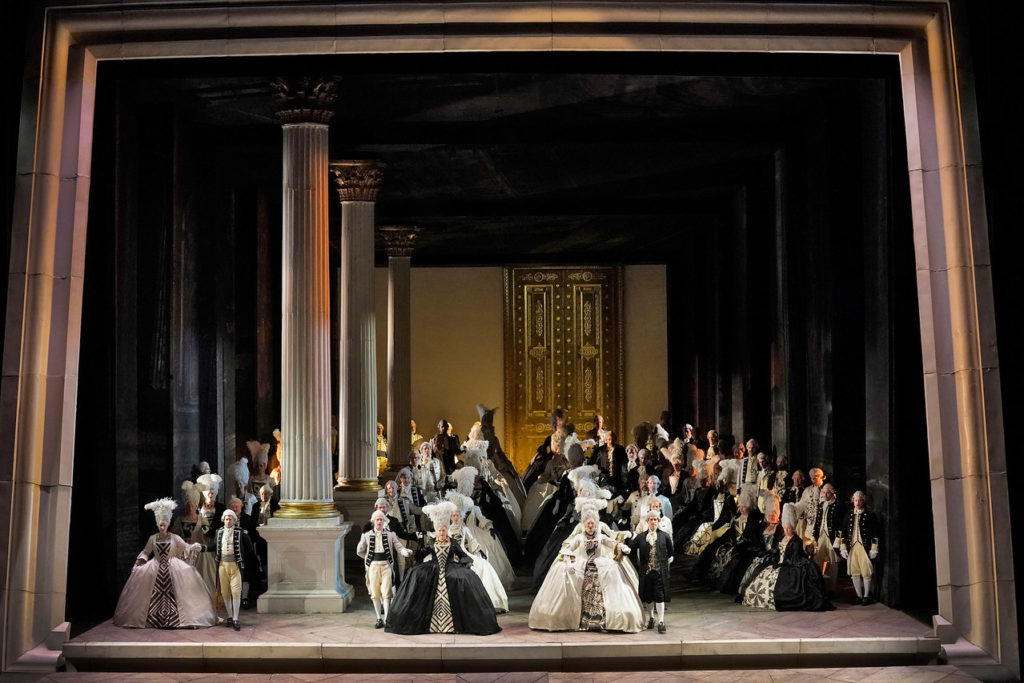
(Credit: Metropolitan Opera / Ken Howard )
Symphonist
Conductor Vasily Petrenko managed all of this musical activity with great elegance and poise. From the first note until the last one, he proved a tremendous collaborator for his artists, every note placed where it should. Everyone seemed to be on the same page under his guidance.
But he wasn’t just an accompanist, but proved himself a symphonic poet, giving Tchaikovsky’s music shape and drive. Even though he had to deal with constant curtains between scenes, he never flagged in having scenes build on top of one another and as such you got the sense of the opera’s increasing darkness taking over from the start with every texture of the orchestra perfectly visible. This was particularly chilling in the final scene of Act three with its incessant lower string ostinato haunting Hermann’s entrance into the Countess’ chambers. Even as the main violin melody seemed to build, the lower strings retained their consistency, creating a truly potent and frightful effect. It felt like the unyielding, cold presence of death.
Not only he did have a strong sense of the ensemble and balancing it in the hall, but he also had command of the dynamic rises and falls, never favoring one section or singer over the other and creating a very strong sense of dramatic cohesion. Tempi fluctuated seamlessly and you just felt like you were in very sure hands all the way through.
It must also be noted that his ability to shift in styles was at the core of this performance’s greatest success. The pastorale could feel like a drag for a number of reasons. It cuts up the main action and stylistically could be feel like a jarring shift emotionally for the audience. This generally comes from conductors who give this section too much weight in an attempt to give the Mozartian style music Tchaikovskian consistency so that it feels “connected” to the other musical material that comes before and after. But Petrenko seemed to understand that this opera is all about the emotional contrasts and you really felt that you were being transported into another world altogether. Instead of disrupting from the opera, it enhanced the experience, alienating the viewer from the heavy-hitting melodrama for a brief moment, releasing the built-up tension and allowing for a moment of relief. Furthermore, it allowed the piece to have a greater symphonic structure, that singular scene in the middle of the performance feeling like a movement unto itself.
“The Queen of Spades” was one of those rare performances that seemed to get better and better as the night wore on and proved all the more memorable for it. This is an opera that truly has it all and as interpreted in this production, seemingly so much more.


